Keep Your Husky Happy!
Happiness Level
Huskies are energetic, intelligent dogs. They need plenty of mental and physical stimulation to stay happy and well-behaved.
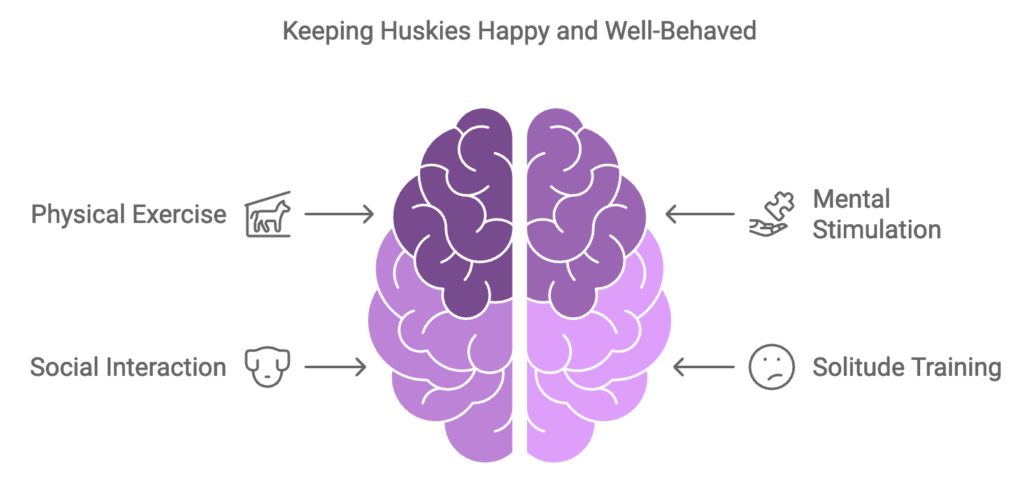
Keeping a Husky entertained involves regular exercise, engaging activities, and social interaction. These active canines thrive on at least 30-60 minutes of vigorous exercise daily. This helps burn off their excess energy and prevents destructive behaviors.
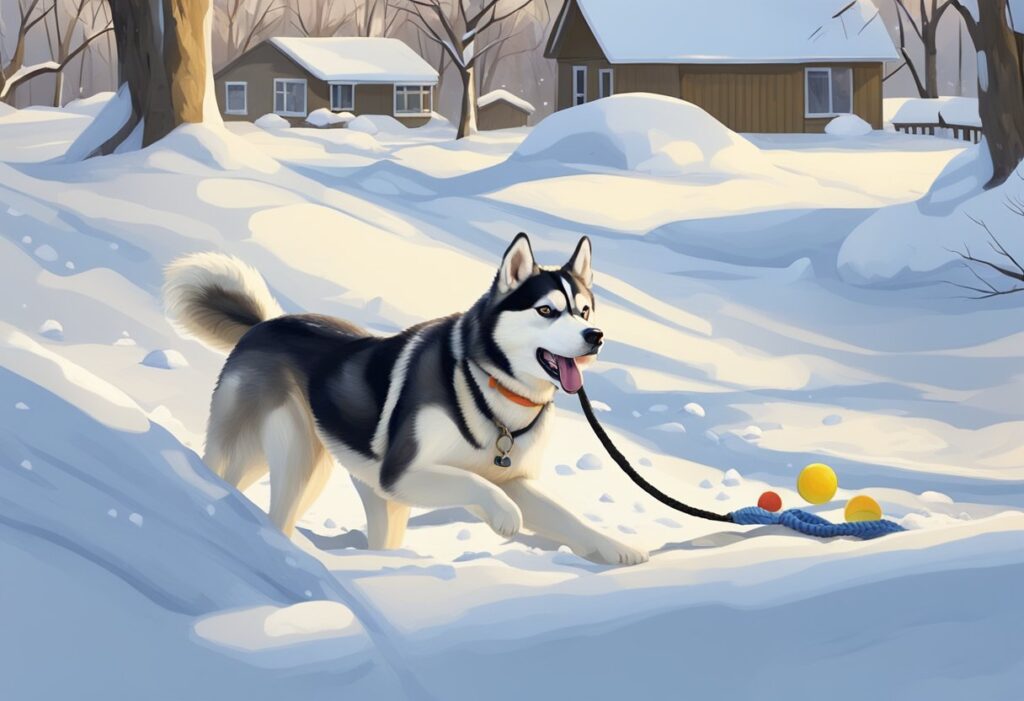
Mental stimulation is equally important for Huskies. Providing puzzle toys, training sessions, and interactive games can keep their minds sharp and prevent boredom.
When left alone, Huskies may become anxious or destructive. So, it’s crucial to gradually accustom them to solitude and provide appropriate entertainment options.
Key Takeaways
- Huskies need daily exercise and mental stimulation to stay happy and well-behaved
- Puzzle toys, training, and interactive games help keep Huskies mentally engaged
- Gradually acclimating Huskies to being alone prevents anxiety and destructive behaviors
Understanding Huskies
Siberian Huskies are active, intelligent dogs with unique needs and behaviors. They require dedicated owners who can provide ample physical and mental stimulation to keep them happy and healthy.
Siberian Husky Characteristics
Huskies are medium-sized working dogs known for their striking appearance and vibrant personalities. They typically weigh between 35-60 pounds and have a thick double coat that comes in various colors and patterns. Their almond-shaped eyes can be blue, brown, or heterochromatic.
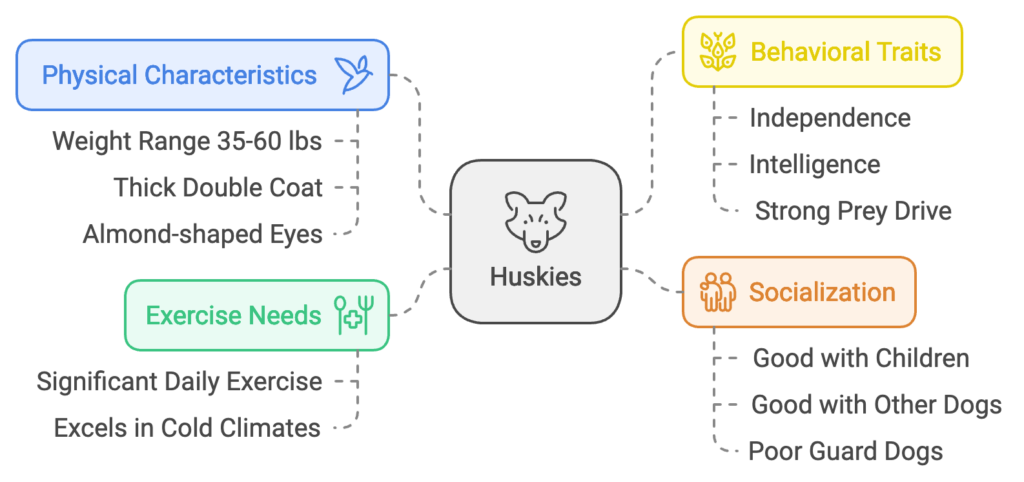
Huskies are highly energetic and require significant daily exercise. They excel in cold climates due to their origins as sled dogs in Siberia. These dogs are known for their independence, intelligence, and strong prey drive.
Huskies are generally friendly and outgoing, making them poor guard dogs but excellent companions. They often get along well with children and other dogs when properly socialized.
Common Behaviors and Needs
Huskies have high energy levels and need plenty of physical activity. Daily walks, runs, or play sessions are essential to prevent boredom and destructive behaviors. They also excel in dog sports like sledding, skijoring, and agility.
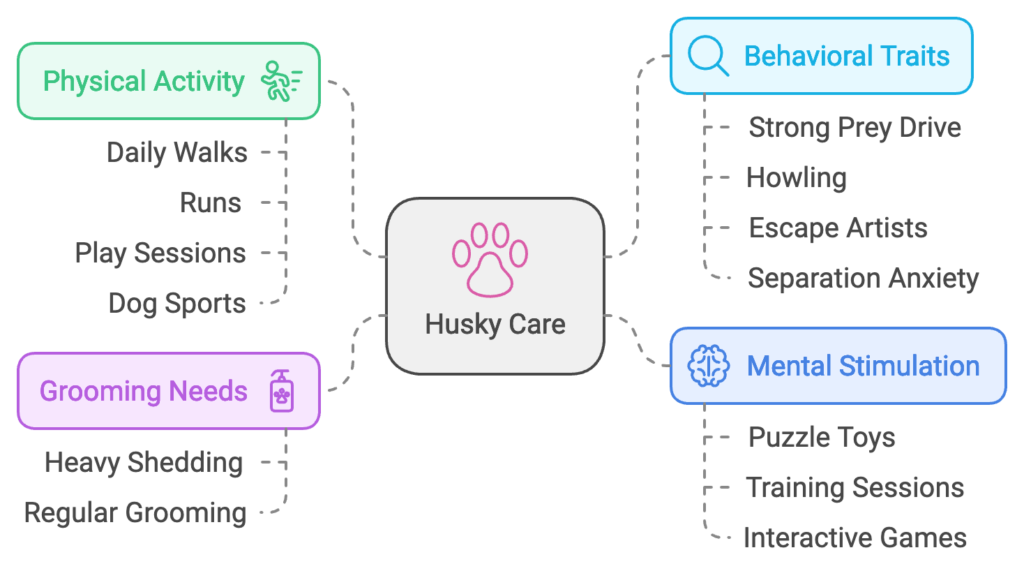
Mental stimulation is crucial for a happy Husky. Puzzle toys, training sessions, and interactive games can help satisfy their intelligent minds. Without proper stimulation, Huskies may become destructive or develop problem behaviors.
These dogs have a strong prey drive and may chase small animals. Secure fencing is necessary, as Huskies are known escape artists. They also have a tendency to howl and “talk” rather than bark.
Huskies shed heavily twice a year and require regular grooming. They thrive on companionship and may suffer from separation anxiety if left alone for long periods.
Mental Stimulation Strategies
Huskies are intelligent dogs that thrive on mental challenges. Providing mental stimulation keeps them engaged, reduces boredom, and prevents destructive behaviors.
Interactive Puzzle Toys
Puzzle toys are excellent for keeping huskies mentally stimulated. These toys require problem-solving skills to access treats or rewards.
Kong toys filled with frozen peanut butter or kibble provide long-lasting entertainment. Meanwhile, treat-dispensing balls encourage physical activity while engaging the mind.
Snuffle mats tap into a husky’s natural foraging instincts, requiring them to use their nose to find hidden treats.
For more advanced huskies, consider multi-level puzzle toys with sliding compartments or flip-lid designs. Rotate toys regularly to maintain interest and prevent boredom.
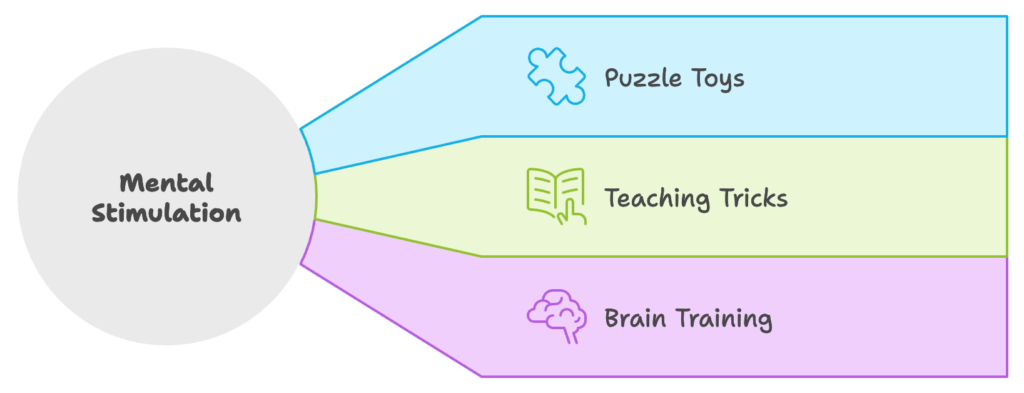
Teaching New Tricks
Teaching new tricks is an effective way to challenge a husky’s mind. Start with basic commands like “sit,” “stay,” and “come.”
Progress to more complex tricks such as “roll over,” “play dead,” or “speak.” Use positive reinforcement techniques, rewarding success with treats or praise.
Keep training sessions short, around 5-10 minutes, to maintain focus and enthusiasm. Incorporate hand signals along with verbal commands to engage multiple senses.
Teach practical skills like “leave it” or “drop it” to enhance everyday obedience.
Brain Training for Dogs
Brain training exercises specifically target a husky’s cognitive abilities. Hide-and-seek games encourage problem-solving and utilize their keen sense of smell.
Start by hiding treats around the house, then progress to hiding yourself or family members. Name recognition exercises for toys help expand a husky’s vocabulary.
Introduce new toys with distinct names, then ask them to fetch specific items. Obstacle courses combine physical activity with mental challenges. Use household items to create simple courses, guiding your husky through with commands. Gradually increase complexity as they master each level.
Physical Exercise Options
Huskies thrive on vigorous physical activity to stay healthy and content. Engaging them in diverse exercises helps channel their energy positively while strengthening the bond between dog and owner.
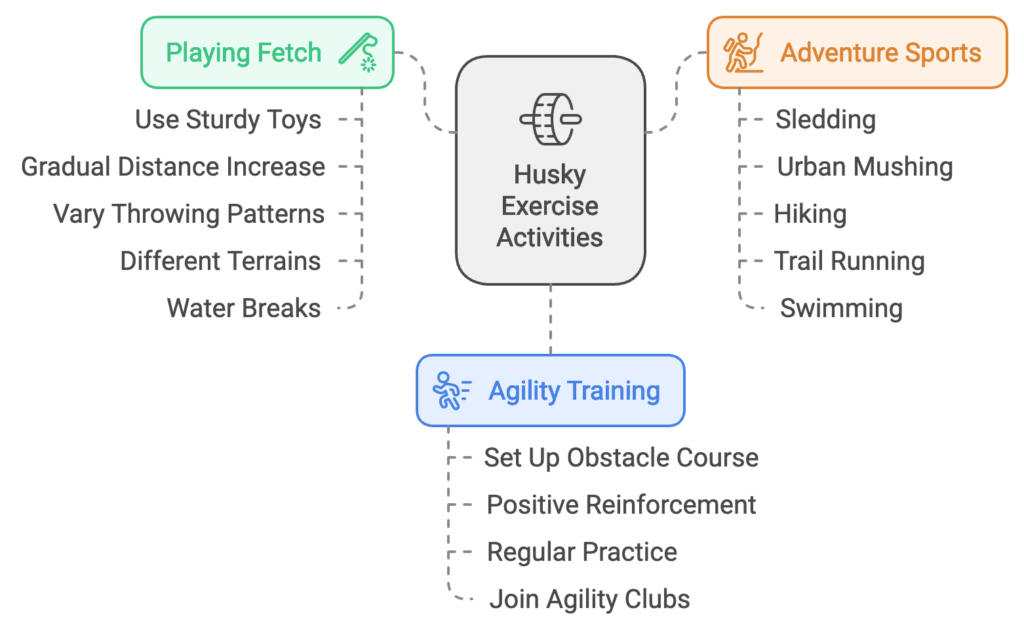
Playing Fetch
Fetch is an excellent way to provide Huskies with both mental and physical stimulation. Use sturdy toys designed for large breeds, such as rubber balls or frisbees.
Start with short distances and gradually increase as your Husky becomes more proficient. Vary the throwing patterns to keep the game interesting.
Incorporate different terrains like grass, sand, or shallow water to add challenge. For extra excitement, try uphill fetches to increase the workout intensity. Remember to provide plenty of water breaks, especially during warm weather.
Agility Training
Agility training combines physical exercise with mental challenges, perfect for intelligent and athletic Huskies.
Set up a basic obstacle course in your backyard using items like tunnels, jumps, weave poles, and pause tables. Start with simple obstacles and gradually increase difficulty.
Use positive reinforcement techniques to encourage your Husky through the course. Practice regularly to improve coordination and build confidence.
Agility training also strengthens the bond between you and your Husky as you work together to navigate the course. Consider joining local agility clubs for structured training and competitions.
Adventure Sports
Huskies excel in adventure sports that tap into their natural endurance and love for the outdoors. Sledding is an obvious choice, allowing them to embrace their heritage.
In warmer climates or off-season, try urban mushing with a specialized scooter or bike attachment. Hiking and trail running are excellent alternatives, providing both exercise and sensory stimulation.
Start with shorter trails and gradually build up to longer distances. Always carry water and take frequent breaks.
For water-loving Huskies, introduce them to swimming or dock diving. These low-impact activities provide a full-body workout while keeping them cool. Ensure your Husky wears a life jacket when near deep water.
Interactive Play and Games
Interactive games provide mental stimulation and physical exercise for Huskies. These activities strengthen the bond between dog and owner while alleviating boredom.
Tug-Of-War
Tug-of-war is an excellent game for Huskies. Use a sturdy rope toy designed for large breeds.
Set clear rules and teach the “drop it” command before starting. Play in short sessions of 5-10 minutes to prevent overstimulation.
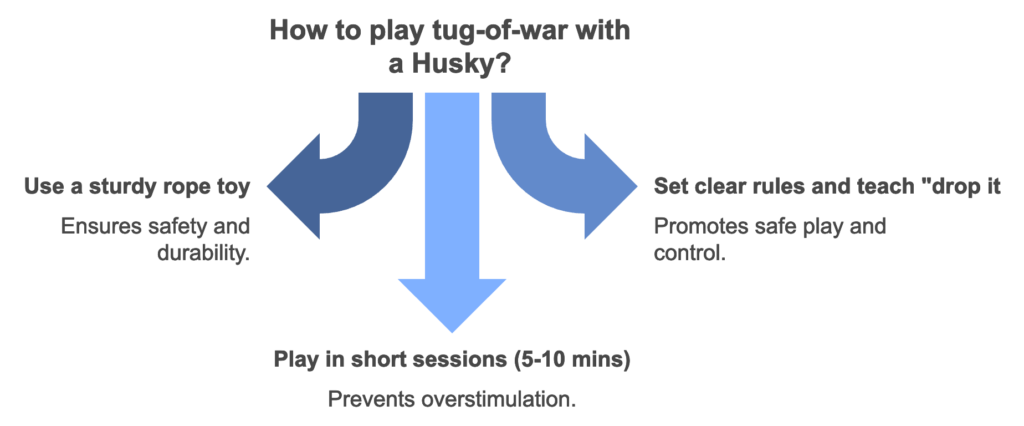
Allow the Husky to win occasionally to maintain interest. Incorporate obedience commands during play, asking for a “sit” or “down” before resuming the game.
Hide-And-Seek
Hide-and-seek taps into a Husky’s natural hunting instincts. Start by having someone hold the dog while you hide. Call the Husky’s name once hidden.
Gradually increase difficulty by hiding in less obvious spots. Use treats or favorite toys as rewards when found. This game can be played indoors or outdoors.
For variation, hide treats or toys around the house. Encourage the Husky to “find it” using their nose. This combines hide-and-seek with scent work for added mental challenge.
Scent Games
Scent games harness a Husky’s powerful sense of smell. Begin with the “which hand” game, hiding a treat in one closed fist. Let the dog choose the correct hand.
Progress to hiding treats around a room. Start with easy spots and gradually increase difficulty. Use a specific command like “search” to initiate the game.
For advanced scent work, introduce scent trails. Drag a treat along the floor, creating a path for the Husky to follow. This mimics tracking and provides intense mental stimulation.
Behavior and Well-Being
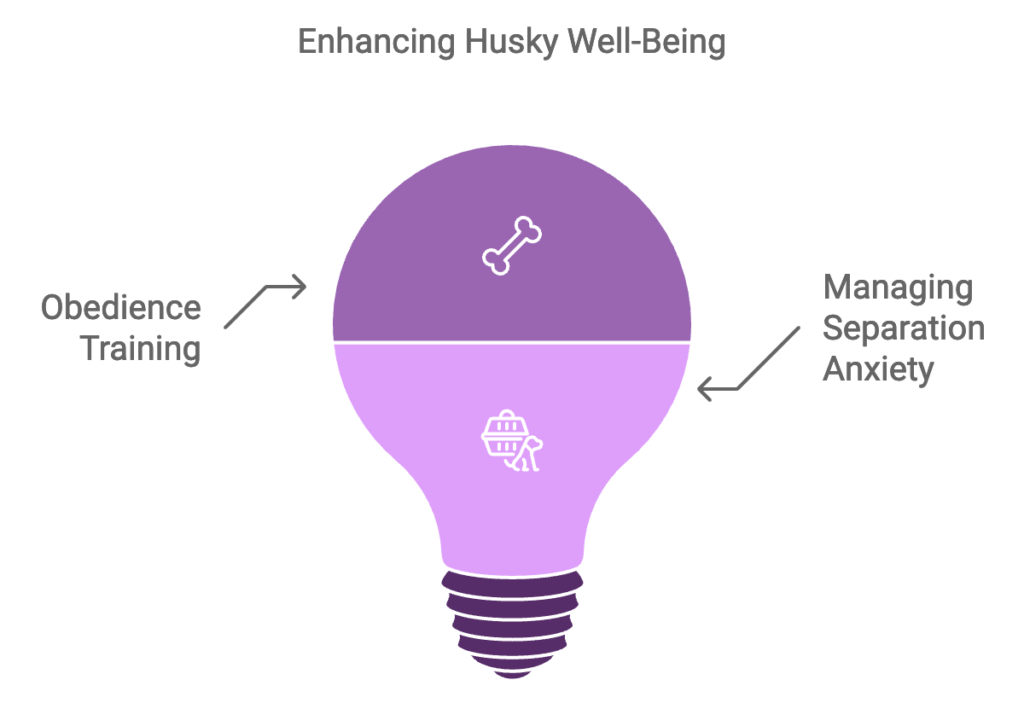
Proper training and addressing emotional needs are crucial for a husky’s behavior and overall well-being. These elements help create a balanced, happy dog and strengthen the bond between pet and owner.
Obedience Training
- Obedience training is essential for huskies, known for their independent and sometimes stubborn nature. Start training early, using positive reinforcement techniques.
- Reward good behavior with treats, praise, or toys. Focus on basic commands like “sit,” “stay,” and “come.”
- Practice commands daily in short sessions to maintain interest. Advanced training can include agility courses or specialized tasks, which provide mental stimulation and physical exercise.
- Professional training classes can be beneficial. They offer structured learning environments and socialization opportunities with other dogs.
Managing Separation Anxiety
- Huskies are social animals and may develop separation anxiety when left alone.
- Gradual desensitization can help. Start with short absences and gradually increase the duration.
- Create a safe, comfortable space for your husky when you’re away.
- Provide engaging toys, particularly puzzle feeders or treat-dispensing toys.
- Consider using calming aids like pheromone diffusers or anxiety wraps.
- Background noise from a radio or TV can also help soothe anxious huskies.
- Regular exercise before leaving can tire your husky, promoting relaxation during your absence.
- A tired dog is less likely to engage in destructive behaviors.
- Chew toys can redirect anxiety-induced chewing.
- Rotate toys to maintain interest and prevent boredom.


Leave a Reply